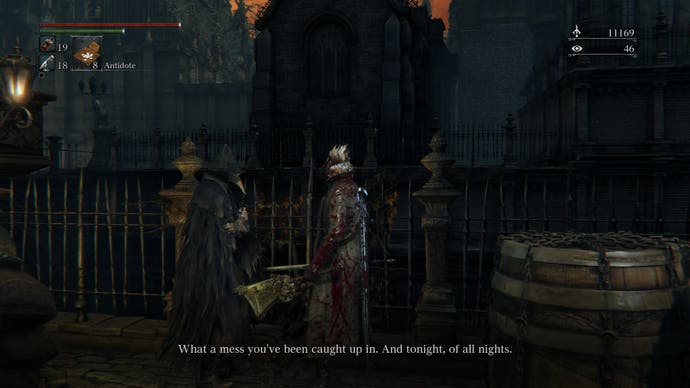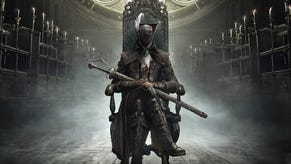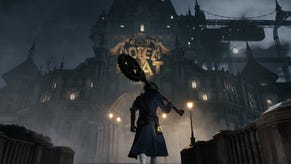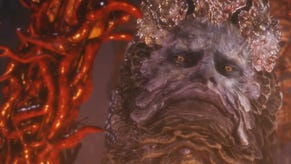Bloodborne review
The second coming.
(This is our final review of Bloodborne, and contains discussions of some of the game's surprises and themes. If you'd rather not read them, have a look at our spoiler-free first impressions from earlier in the week, or skip to the last paragraph.)
There is a point in Bloodborne when the details of this strange world begin to combine and form patterns. I noticed that my favourite hat also came with what looks like gauze covering the eyes. Didn't that hunter in the opening cutscene have this too? And why do all these statues have their eyes covered? What at first seems to be coincidence soon looks very different.
In a nutshell, this is one of the reasons that games directed by Hidetaka Miyazaki inspire such fanatical following. The mechanics and themes cohere with an integrity that is so unusual in games, and puzzling out what's going on becomes as much part of the experience as slaughtering your prey. Consider the eyes. A core part of Bloodborne's system is Insight, something of a currency that is used to buy special items and summon other players.
But Insight also changes the game. You start with no Insight but, after gaining your first part of it, can communicate with the living doll that levels you up. Once you hit ten Insight, a new group of merchants appear. Once you hit 15 Insight enemies get tougher, gaining additional attacks and elemental damage. Once you hit certain other landmarks, your hunter starts to see the entire world - and things in it - very differently.
The foundation of Bloodborne's lore is H.P. Lovecraft's Cthulhu mythos. Though it has been much-expanded by other authors, with sometimes dubious results, Lovecraft's creation is basically an amoral universe where humankind has absolutely no significance, cosmic beings do malevolent things because they can, and those who can perceive this state of affairs are driven mad by the knowledge. As your hunter gains more Insight, s/he begins to both see the world as it really is and lose their grip on 'reality.' The humanoid enemies in Yharnam hate and fear you, shouting "foul beast" and "away, away!" It is heavily implied, not least by another hunter you defeat in Old Yharnam, that the things you're killing may not be what you think they are.
If that is speculation, then the way Bloodborne's world warps as your Insight increases is fact - your outlook on entire locations will change once you see what's really there. In a mechanical sense this is an elegant new take on the world tendency system in Demon's Souls, which changed elements of the levels but was a bit of a pain to control. Here it's a one-way street but the effect is if anything more striking, and certainly more unsettling. It goes even further. Your hunter, when seeing certain enemies or locations, starts going crazy: a stat called 'Frenzy' builds up and, if not managed with sedatives or simply running away, will cause huge physical damage that stacks with your level of Insight. It is hard to think of any other game, outside of the Souls series, that intertwines ideas across aesthetics, narrative and mechanics.

Bloodborne's locations wring so much from this because they're special in the first place. Yharnam is enormous, a warren-like Victoriana by gaslight where there's a discovery around every corner. The sheer detail packed into each location is one thing, but the way it unfolds organically while linking back-and-forth is a stunning achievement. Dark Souls' Lordran and Demon's Souls' Castle Boletaria are the obvious comparisons but only so useful - Yharnam has the same principle of geographical coherence but is far more sprawling and, because of this, a little less interconnected. They use the same methods but with different, equally wonderful results.
This has a wider application. The Souls games are touchstones for Bloodborne, not least because little else can touch them, and many design elements are either carried over wholesale or adapted. But Bloodborne is much more distinct from these predecessors than this suggests. The most important example is the combat system, which is designed for fast and aggressive engagements where the player should always be attacking. The complete lack of shields (bar one item included as a gag) means that your only defence is dodging - an active and timing-based skill, as opposed to holding L1.
Several elements tie this together. After taking damage you have a few seconds to regain that health by attacking enemies, which lets you sustain through longer engagements without backing off to heal. The dodge changes function: a roll when you're not targeting anything, and a faster sidestep when locked-on. The latter is a move of huge utility, and only uses a small amount of stamina, allowing you to zone in and out of fights as well as twinkletoes it around larger foes. But the most important tool outside of your main weapon, in PvE and PvP, is the gun.
There are many distinct firearms in Bloodborne, from long-range pistols and rifles to a blunderbuss or flamethrower, and almost all of them can 'counter-shot' an enemy attack at the right moment and leave them stunned. In this state you can execute a devastating attack where your hunter thrusts their hand into the enemy's body and flings them away with explosive force, an amazing-looking move accompanied by a booming sound effect. In PvE the application is relatively simple, but in PvP it becomes more varied and essential.
Online in Bloodborne is a streamlined system that still revolves on the idea of either co-operating with other players to help smash bosses, or 'invading' the world of some luckless prey and hunting them. An especially nice touch is that, when you successfully summon another player to help, a bell-ringing NPC appears somewhere in your world - and rings her bell to attract invaders. This NPC also appears when you try to invade the worlds of others, a beautiful mechanic that means the dedicated PvP-ers are fighting each other as much as they're invading PvE players.

The gun is critical in Bloodborne's PvP because it can interrupt every significant action from an opponent. Both players have their stock of 20 Blood Vials, the default healing item, and so theoretically fights could go on for ages. But the engagements are so fast and brutal that you'll either be killing people with quickfire combos, or doing so much damage that the chase begins - the wounded party tries to run away and find a safe spot to heal, while the aggressor hotfoots it close behind. If someone tries to heal in the open? Boom, counter-shot, or at least an interruption. If they're tossing molotovs or knives? Boom, counter-shot.
There's even an item dedicated to stopping other hunters from healing for a limited time. I hit one opponent with this and then did some damage, at which point s/he panicked so much they backstepped over a platform edge, barely survived the fall, and started spamming the heal button in the middle of an enemy group. I watched the shrugging 'can't heal' animation from above, which finished just as the enemies ripped them apart. For the last few moments of life this poor person was clearly bricking it. You can't buy satisfaction like that.
Co-op is equally thrilling, and there's something intensely righteous about helping out other players in a game as unforgiving as Bloodborne - because you've been there. Certain bosses must have killed me twenty times. And so going into another world to be the helping hand that tips someone else over the edge feels both noble and like some sort of karmic revenge on From Software's villainous AI. When an invader turns up and you protect the host it's even better - YOU SHALL NOT PASS! - and when you fail and die or the host falls, it's devastating. Bloodborne balances these possibilities remarkably well and part of the reason multiplayer is so enjoyable is it's so unpredictable. You never know what's going to happen.
So we come to the trick weapons, Bloodborne's central tools and at bottom an extrapolation from Monster Hunter's form-changing Switch Axe. There are ten trick weapons, all of which have two forms - which seemed meagre, only because the Souls games offer such a wide range of offensive hardware. But the trick weapons are much more than they seem. For a start each one's form dictates the moveset and impact, so ten weapons is really twenty, and the number of possible combos with each one is far greater than a Souls weapon would have. They also, by allowing you to switch forms mid-combo, introduce an on-the-fly level of strategy that lets you re-adjust to new factors like an additional enemy joining in.
More than anything, however, the trick weapons are great fun to use and look incredible. The animations are just intoxicating: I use Ludwig's Holy Blade, which is a 'normal' sword that can be jammed into a huge scabbard and then used as a greatsword. The way the first clanks into the second sounds and looks amazing, but the way your hunter switches them around when transitioning modes - with long swings looping into short swings, and perfect rhythm accentuated by those clanks - has more flair than entire other games. The various weapons all work so differently, too, that each justifies its inclusion with little crossover. Last night I invaded some chap with a cane and a top hat, and as I was thinking about an easy win he got one quick hit in and then whipped me to death.
Against this is a gaggle of NPCs that run from humans with hatchets to cosmic freaks and malformed void-monsters. Underestimating any enemy, even dogs, is a fast way to die. And there's one later foe in particular, an eyeball-infested goomba-shaped thing, that simply scares me. These things frenzy you on sight, dealing massive damage if it takes hold, and while you're trying to mitigate this with items or hiding will chase down and try to grab you - at which point they basically reveal a mass of tiny fanged mouths and start chewing your head off. When I see one of these things, nevermind two, I plan out the encounter in a way I rarely do for 'standard' enemies - and it still goes wrong a lot of the time. I'm terrified of fighting these things, and the last time I had that feeling was the Tower of Latria.

Then the bosses. Bloodborne's marquee events are as diverse as they are challenging, mixing huge deathbeasts, human-sized opponents, and unique encounters. Some test your twitch skills, some are more like puzzles to be worked out, and many cycle through different stages during the encounters. Several, particularly lategame, left me open-mouthed. And with the last boss From Software exorcises the memory of Gwyn: Dark Souls' final encounter is wonderful for lots of reasons, but undercut by how easy it is to parry the Lord of Sunlight. Bloodborne's final battle has an equally stunning setting, and also allows for parries, but is much less predictable and - as the final test for your skills - simply exhilarating to take part in.
These bosses are only the start, because there are another 30 or so to be found in Bloodborne's Chalice Dungeons. These areas can be created through finding chalices, and in hunting through them you find loot that includes other chalices - among which may be a root chalice, which allows the creation of semi-procedural dungeons. That is, pre-made rooms are used as building blocks but stuck together in different configurations based on core principles: there will always be a boss door, for example, and this will always be unlocked by a special lever elsewhere on that floor.
The Chalice Dungeons are a great idea, and introduce a whole new level of replayability. The pre-made configurations are uniformly excellent, with plenty of hidden secrets (illusory walls!) and phat loot to be had. But once you start experimenting with root chalices the algorithm creates equally-interesting layouts, with random loot acting as a huge enticement for exploration. The risk with these dungeons was always that they would feel either half-assed or inconsequential, but as it is the structure allows From Software's designers to retain control where it matters, over individual room configurations, while feeding that greedy part of our nature that just loves finding treasure.
Even better, every floor is punctuated by a boss fight - and when these bosses come to be re-used in later dungeons, as is inevitable, the fights change. One fight features three enemies, and the first time this happened in a room with pillars that allowed me to heal and avoid being swarmed. Several dungeons later they turned up again but in an empty circular arena, which made the fight much tougher and forced new tactics.
You do see some repetition that isn't handled quite as well, and a few times my root chalices have generated extremely similar dungeons - which may be bad luck, or indicative of a long-term problem. But even so, this element brings something entirely new to Bloodborne and - so far - I can't get enough.

The Chalice Dungeons also make up for a disappointing NG+ experience. This is the one thing Dark Souls 2 managed very well by changing enemy positions and introducing new items. Both Demon's and Dark were basically the same game but harder, and that's what Bloodborne offers. This is completely fine, of course, and NG+ is still a great thing in and of itself - but you do wish the development team had taken some inspiration from their colleagues.
Sadly this is not the end of Bloodborne's problems. The biggest is framerate drops, which particularly in multiplayer can be crippling. Making an action game 30FPS is a compromise in the first place, so the least that can be expected is a rock-solid 30FPS. It's not endemic, and so hardly game-ruining, but in an otherwise exquisitely-chiselled production such a technical failing is tragic.
The blood vials also seem slightly out of balance. These consumables are the basic health item, so you use a lot, but are obtained through (frequent) drops or by purchasing them. Now I'm in NG+ I have 20 at all times plus 99 in storage. But there were times during the first playthrough, stuck on a boss, where I simply ran out and had to grind them before making another attempt. This seems an unnecessary design complication, and one that will disproportionately hurt newer or less-skilled players. The difficulty of Bloodborne is part of the appeal, and why it feels so great when you eventually conquer its challenges. But limiting an essential consumable doesn't feel part of that, so much as an artificial and unnecessary barrier.
These flaws, however, are like the tiny cracks in the Sistine Chapel's ceiling. They exist but, in the context of such a masterpiece as Bloodborne, they don't diminish the achievement.
The fact is that few other studios in the world can match what From Software is doing in big-budget games. Director Hidetaka Miyazaki is possessed of a rare talent, an all-encompassing design sensibility capable of tying everything that matters - aesthetics, narrative, sound and mechanical design - together in a manner where each feeds into and enhances the others. The structure underlying Bloodborne is not just original but coherent, and because of this the impact of everything it does is commensurately greater. This is total design. It feels wonderful to have a world like this and, over a week of solid play later, feel that there's so much more to discover. And it's awful to know that, in all likelihood, it will be a painfully long time until I play anything else that matches up to Bloodborne's breadth of vision, generosity of content, and - yes - genius.




.png?width=291&height=164&fit=crop&quality=80&format=jpg&auto=webp)












